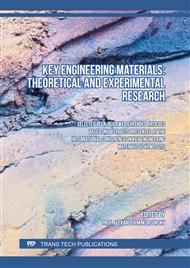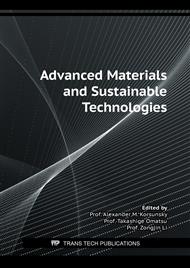[1]
Oommen, T. V. (2002). Vegetable oils for liquid-filled transformers. IEEE Electrical Insulation Magazine, 18(1), 6–11. https://doi.org/10.1109/57.981322.
DOI: 10.1109/57.981322
Google Scholar
[2]
Perrier, C., & Beroual, A. (2009). Experimental investigations on insulating liquids for power transformers: Mineral, ester, and silicone oils. IEEE Electrical Insulation Magazine, 25(6), 6–13. https://doi.org/10.1109/mei.2009.5313705.
DOI: 10.1109/mei.2009.5313705
Google Scholar
[3]
Sitorus, H. B. H., Setiabudy, R., Bismo, S., & Beroual, A. (2016). Jatropha curcas methyl ester oil obtaining as vegetable insulating oil. IEEE Transactions on Dielectrics and Electrical Insulation, 23(4), 2021–2028. https://doi.org/10.1109/TDEI.2016.7556474.
DOI: 10.1109/tdei.2016.7556474
Google Scholar
[4]
Yu, H., Yu, P., & Luo, Y. (2017). Renewable low-viscosity dielectrics based on vegetable oil methyl esters. Journal of Electrical Engineering and Technology, 12(2), 820–829. https://doi.org/10.5370/JEET.2017.12.2.820.
DOI: 10.5370/jeet.2017.12.2.820
Google Scholar
[5]
Alicia, C. P. Y., W, R., Khalid, M., Rasheed, A. K., & Gupta, T. (2016). Synthesis and thermo-physical characterization of graphene based transformer oil. Journal of Engineering Science and Technology, 11, 140–152.
Google Scholar
[6]
Bhunia, M., Panigrahi, K., Das, S., Chattopadhyay, K., & Chattopadhyay, P. (2018). Amorphous graphene – Transformer oil nanofluids with superior thermal and insulating properties. Carbon, 139. https://doi.org/10.1016/j.carbon.2018.08.012.
DOI: 10.1016/j.carbon.2018.08.012
Google Scholar
[7]
Dhar, P., Chattopadhyay, A., Maganti, L. S., & Harikrishnan, A. R. (2019). Streamer evolution arrest governed amplified AC breakdown strength of graphene and CNT colloids. EPJ Applied Physics, 85(3), 1–11. https://doi.org/10.1051/epjap/2019180360.
DOI: 10.1051/epjap/2019180360
Google Scholar
[8]
Wajanasoonthon, K., & Suksri, A. (2021). Electrical Breakdown Voltage of Palm Oil and Nano Graphene Filler in Nanofluids Application on Transformer Insulating Oil. Key Engineering Materials, 902, 59–63. https://doi.org/10.4028/www.scientific.net/KEM.902.59.
DOI: 10.4028/www.scientific.net/kem.902.59
Google Scholar
[9]
Yang, L., Liao, R., Caixin, S., & Zhu, M. (2011). Influence of vegetable oil on the thermal aging of transformer paper and its mechanism. IEEE Transactions on Dielectrics and Electrical Insulation, 18(3), 692–700. https://doi.org/10.1109/TDEI.2011.5931054.
DOI: 10.1109/tdei.2011.5931054
Google Scholar
[10]
Sun, C. C., Xiao, C., Hou, J., Kong, L., Ye, J., & Yu, W. J. (2020). Analysis of Factors Affecting Temperature Rise of Oil-immersed Power Transformer. Journal of Physics: Conference Series, 1639(1). https://doi.org/10.1088/1742-6596/1639/1/012087.
DOI: 10.1088/1742-6596/1639/1/012087
Google Scholar
[11]
Rajab, A., Tsuchie, M., Kozako, M., Hikita, M., & Suzuki, T. (2018). Properties of thermally aged natural esters used as insulating liquid. International Journal on Electrical Engineering and Informatics, 10(2), 220–231. https://doi.org/10.15676/ijeei.2018.10.2.2.
DOI: 10.15676/ijeei.2018.10.2.2
Google Scholar
[12]
Fernández, I., Valiente, R., Ortiz, F., Renedo, C. J., & Ortiz, A. (2020). Effect of TiO2 and zno nanoparticles on the performance of dielectric nanofluids based on vegetable esters during their aging. Nanomaterials, 10(4), 1–18. https://doi.org/10.3390/nano10040692.
DOI: 10.3390/nano10040692
Google Scholar
[13]
ASTM D445-06. (2008). Standard Test Method for Kinematic Viscosity of Transparent and Opaque Liquids (and Calculation of Dynamic Viscosity). Manual on Hydrocarbon Analysis, 6th Edition, 1–10.
DOI: 10.1520/mnl10842m
Google Scholar
[14]
Calcara, L., Pompili, M., Sangiovanni, S., Baur, M., & Knauel, J. (2018). Standard Evolution for the Determination of the Power Frequency Breakdown Voltages in Insulating Liquids. Annual Report Conference on Electrical Insulation and Dielectric Phenomena, CEIDP, 2018-October, 263–266. https://doi.org/10.1109/CEIDP.2018.8544887.
DOI: 10.1109/ceidp.2018.8544887
Google Scholar
[15]
Sima, W., Shi, J., Yang, Q., Huang, S., & Cao, X. (2015). Effects of conductivity and permittivity of nanoparticle on transformer oil insulation performance: Experiment and theory. IEEE Transactions on Dielectrics and Electrical Insulation, 22(1), 380–390. https://doi.org/10.1109/TDEI.2014.004277.
DOI: 10.1109/tdei.2014.004277
Google Scholar
[16]
Huang, Z., Wang, F., Wang, Q., Yao, W., Sun, K., Zhang, R., … Li, J. (2019). Significantly Enhanced Electrical Performances of Eco-Friendly Dielectric Liquids for Harsh Conditions with Fullerene. Nanomaterials , Vol. 9. https://doi.org/10.3390/nano9070989.
DOI: 10.3390/nano9070989
Google Scholar
[17]
Makmud, M. Z. H., Illias, H. A., Chee, C. Y., & Dabbak, S. Z. A. (2019). Partial discharge in nanofluid insulation material with conductive and semiconductive nanoparticles. Materials, 12(5). https://doi.org/10.3390/MA12050816.
DOI: 10.3390/ma12050816
Google Scholar



